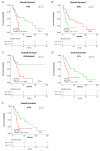OSucs: An Online Prognostic Biomarker Analysis Tool for Uterine Carcinosarcoma
- PMID: 32899312
- PMCID: PMC7563768
- DOI: 10.3390/genes11091040
OSucs: An Online Prognostic Biomarker Analysis Tool for Uterine Carcinosarcoma
Abstract
Background: Uterine carcinosarcoma (UCS) is a type of rare and aggressive tumor. The standard treatment for UCS involves surgical treatment followed by radiochemotherapy. Clinical outcomes of UCS patients are poor due to high metastasis and relapse rate. Therefore, new targeted therapy strategies for UCS are needed. Because UCS is highly heterogenous, it is critical to identify and develop prognostic biomarkers to distinguish molecular subtypes of UCS for better treatment guidance.
Methods: Using gene expression profiles and clinical follow-up data, we developed an online consensus survival analysis tool named OSucs. This web tool allows researchers to conveniently analyze the prognostic abilities of candidate genes in UCS.
Results: To test the reliability of this server, we analyzed five previously reported prognostic biomarkers, all of which showed significant prognostic impacts. In addition, ETV4 (ETS variant transcription factor 4), ANGPTL4 (Angiopoietin-like protein 4), HIST1H1C (Histone cluster 1 H1 family member c) and CTSV (Cathepsin V) showed prognostic potential in a molecular subtype-specific manner.
Conclusion: We built a platform for researchers to analyze if genes have prognostic potentials in UCS.
Keywords: gene expression profiling; molecular subtype; prognostic biomarker; survival analysis tool; uterine carcinosarcoma.
Conflict of interest statement
The authors declare no conflict of interest.
Figures







Similar articles
-
Identification of distinct molecular subtypes of uterine carcinosarcoma.Oncotarget. 2017 Feb 28;8(9):15878-15886. doi: 10.18632/oncotarget.15032. Oncotarget. 2017. PMID: 28178664 Free PMC article.
-
Uterine carcinosarcoma: Contemporary clinical summary, molecular updates, and future research opportunity.Gynecol Oncol. 2021 Feb;160(2):586-601. doi: 10.1016/j.ygyno.2020.10.043. Epub 2020 Nov 9. Gynecol Oncol. 2021. PMID: 33183764 Review.
-
Adjuvant Treatment Modalities, Prognostic Factors, and Outcome of the Uterine Carcinosarcoma.J Obstet Gynaecol Can. 2021 Jan;43(1):34-42. doi: 10.1016/j.jogc.2020.06.021. Epub 2020 Jul 18. J Obstet Gynaecol Can. 2021. PMID: 33041218
-
HER2-negative or low expression as an unfavorable prognostic factor in patients with stage I/II uterine carcinosarcoma.J Gynecol Oncol. 2025 Jan;36(1):e14. doi: 10.3802/jgo.2025.36.e14. Epub 2024 Jul 2. J Gynecol Oncol. 2025. PMID: 38991945 Free PMC article.
-
Uterine serous carcinoma and uterine carcinosarcoma: molecular features, clinical advances, and emerging therapies.Clin Adv Hematol Oncol. 2024 Jul-Aug;22(6):301-310. Clin Adv Hematol Oncol. 2024. PMID: 39110653 Review.
Cited by
-
Potential role of ANGPTL4 in cancer progression, metastasis, and metabolism: a brief review.BMB Rep. 2024 Aug;57(8):343-351. doi: 10.5483/BMBRep.2024-0082. BMB Rep. 2024. PMID: 39044455 Free PMC article. Review.
-
SOX9: Advances in Gynecological Malignancies.Front Oncol. 2021 Nov 22;11:768264. doi: 10.3389/fonc.2021.768264. eCollection 2021. Front Oncol. 2021. PMID: 34881182 Free PMC article. Review.
References
-
- Matsuo K., Takazawa Y., Ross M.S., Elishaev E., Podzielinski I., Yunokawa M., Sheridan T.B., Bush S.H., Klobocista M.M., Blake E.A., et al. Significance of histologic pattern of carcinoma and sarcoma components on survival outcomes of uterine carcinosarcoma. Ann. Oncol. 2016;27:1257–1266. doi: 10.1093/annonc/mdw161. - DOI - PubMed
-
- Thomakos N., Rodolakis A., Zagouri F., Zacharakis D., Sotiropoulou M., Akrivos N., Haidopoulos D., Papadimitriou C.A., Dimopoulos M.A., Antsaklis A. Serum CA 125, CA 15-3, CEA, and CA 19-9: A prognostic factor for uterine carcinosarcomas? Arch. Gynecol. Obstet. 2013;287:97–102. doi: 10.1007/s00404-012-2529-6. - DOI - PubMed
Publication types
MeSH terms
Substances
LinkOut - more resources
Full Text Sources
Medical

